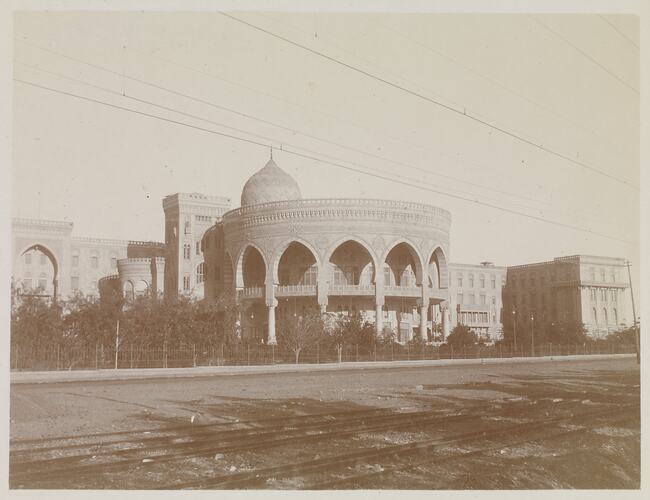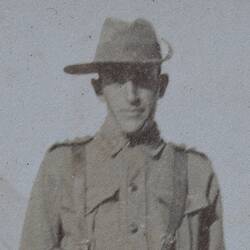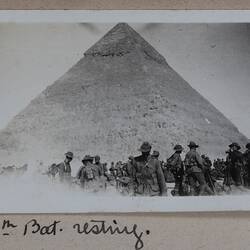Summary
One of 108 images in an album from World War I likely to have been taken by Captain Edward Albert McKenna. The album contains photographs of the 7th Battalion in Egypt.
Image of the Heliopolis Hotel (also known as the Palace Hotel), taken from the back. According to the inscription the hotel was in use as a military hospital.
The Heliopolis Hotel was built in the desert in 1908-10 during the development of the modern suburb Heliopolis in Cairo. It was officially opened in December 1910 as Africa's most luxurious hotel with 400 rooms and 55 private apartments. The hotel closed in 1960 and since the 1980s has served as a Presidential Palace.
The modern suburb of Heliopolis was developed in 1905 by the Heliopolis Oasis Company as an upscale district in north-eastern Cairo. According to the written inscription on the back, the postcard shows the 'electric cars' that ran between Cairo and Heliopolis.
The ancient city of Heliopolis (Greek: 'City of the Sun'; Egyptian: Iunu; Biblical: On) is the oldest city in Egypt, located to the north of the ancient capital of Memphis and believed to have been the religious capital in the Old Kingdom. The only remaining remnant of the city is the obelisk of Senwasret I (12th Dynasty, Middle Kingdom) that was originally erected outside the temple of Re-Atum.
The album relates to the service of Captain Edward Albert McKenna. McKenna, born in Castlemaine, Victoria, was a 36-year-old department manager of soft goods when he enlisted on 17 August 1914. He lived at 5 St James Buildings, William Street, Melbourne, and had been married to Elizabeth ('Lillie') Mary McKenna since 1910. He embarked from Melbourne 19 October 1914 on the HMAT Hororata, and served in the 7th Battalion Australian Infantry.
He was killed in action in Gallipoli around 25-30 April 1915, aged 37. His kit bag was unusually full, even containing seven shirts, a pillow, six towels, a travelling rug, gumboots, and pyjamas and slippers. Also amongst his possessions was a camera, although no photographic prints or albums.
He was buried at 7 Lone Pine Cemetery, Gallipoli. His details appear on the honours roll on the web page of the Australian War Memorial.
Description of Content
Exterior view of the Heliopolis Palace Hotel. A large cylandrical building fronts the Hotel and just behind it a dome is visible. In the foreground of the photograph, in front of the building, a series of train tracks run along the ground.
Physical Description
Black and white photographic print on paper with a white border.
More Information
-
Collection Names
Returned and Services League (RSL) Collection, Military Memorabilia Collection
-
Collecting Areas
-
Acquisition Information
Donation from Mr J. Willis, circa 1986
-
Acknowledgement
Mr. J. Willis
-
Place & Date Depicted
-
Photographer
Captain Edward A. McKenna - Australian Imperial Force (AIF), Heliopolis, Egypt, 1914-1915
-
Creator
-
Inscriptions
Hand written in ink on support underneath the photograph: 'Hotel Heliopolis (view from back) / Taken over by military as Base Hospital / It contains 800 rooms 500 Bathrooms' Hand written in pencil on back of photograph: 'Hotel Heliopolis 800 rooms 500 bathrooms / military people have just taken it over / for base Hospital . I could not get it all in this is the back cannot get / a shot from the front'
-
Classification
-
Category
-
Discipline
-
Type of item
-
Image Dimensions - Photograph
84 mm (Width), 108 mm (Height)
-
Image Dimensions - Photograph album page
174 mm (Width), 141 mm (Height)
Dimensions measurement is of the photograph album page.
-
References
National Archives of Australia: McKenna Edward Albert, barcode 1949283, series B2455/1. 'Heliopolis (Cairo Suburb),' Wikipedia, at: [Link 2]">[Link 1](Cairo_suburb); accessed: August 6, 2012 'Heliopolis (Ancient),' Wikipedia, at: [Link 2]">[Link 1](ancient), accessed: August 6, 2012 Ian Shaw (ed.), The Oxford History of Ancient Egypt, Oxford University Press (Oxford, 2000); p. 86 'Heliopolis Palace,' Wikipedia, at: [Link 2]">[Link 1]Palace accessed: August 6, 2012
-
Keywords


